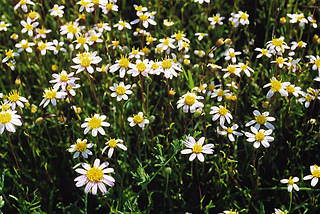(Pentachaeta bellidiflora)
 Pentachaeta bellidiflora. Photo © Doreen Smith.
Pentachaeta bellidiflora. Photo © Doreen Smith.
White-rayed pentachaeta is a California endangered plant species, which means that killing or possessing plants is prohibited by the California Endangered Species Act (CESA). The species is also listed as endangered under the federal Endangered Species Act. White-rayed pentachaeta is a small annual plant with small, white, daisy-like flowers that typically bloom from March to May. White-rayed pentachaeta is found in San Mateo County west of Redwood City at a single population in a location known as the “Triangle.”
According to records in the California Natural Diversity Database, there were fourteen historic occurrences of white-rayed pentachaeta, three of which are presumed to still exist. However, according to the 2010 Five Year Review (PDF) conducted by the U.S. Fish and Wildlife Service, only the occurrence at the Triangle site still exists. Additionally, a small occurrence of this species may have been found on the west side of Upper Crystal Springs Reservoir.
Urbanization, development, and disturbance from off-road vehicles caused the loss of most occurrences of white-rayed pentachaeta. While development does not directly threaten the population at the Triangle, the indirect impacts from surrounding development could threaten this population. There are several invasive and nonnative species present at the Triangle, and further disturbance could allow encroachment into white-rayed pentachaeta habitat. Nitrogen deposition at the Triangle from Interstate 280 could also threaten white-rayed pentachaeta by allowing more nitrogen-loving plants, such as grasses, to establish in its habitat. Extinction due to a stochastic event and climate change are also threats to white-rayed pentachaeta.
In order to prevent the extinction of white-rayed pentachaeta, the management plan in place at the Triangle should include specific goals related to the white-rayed pentachaeta population. The population should be more closely monitored to assess population fluctuations. Further surveys should be conducted for white-rayed pentachaeta, and the possible second occurrence should be verified. Additionally, research should be conducted to identify successful propagation methods for possible future outplantings into its original range. Research should also be conducted to identify pollinators for white-rayed pentachaeta, and to assess their importance to population health.
CDFW may issue permits for white-rayed pentachaeta pursuant to CESA, and you can learn more about the California laws protecting white-rayed pentachaeta and other California native plants. Populations of white-rayed pentachaeta occur in CDFW’s Bay Delta Region. More information is also available from the U.S. Fish and Wildlife Service Species Profile for White-Rayed Pentachaeta.
Updated 01/15/2014